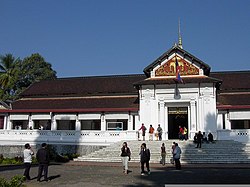Phra Bang
The Buddha image Phra Bang (also Pra Bang, Prabang, Phrabang, Phabang, Pha Bang; "Royal Buddha image that dissolves suffering"; Lao : ພະ ບາງ ) is the most important Buddhist image in Laos . It has been located in the city of Luang Prabang named after the statue since the 14th century.
The statue is 83 cm high and depicts a standing Buddha with the palms facing forward. It consists of bronze covered with gold leaf and, according to tradition, was originally cast in Ceylon between the 1st and 9th centuries . The details of the figure, however, reveal a much later work from the Khmer period. The Phra Bang came to Luang Phrabang from Angkor in 1353 and should contribute to the spread of Theravada Buddhism in the kingdom. In 1359 the Khmer king gave the statue to his son-in-law Fa Ngum , the first king of Lan Xang . The first capital of the empire is named after the portrait: Luang Phrabang.
For a long time the Phra Bang was regarded as a symbol for the rightful ruler of the country, because only a laudable and just rule deserves to be allowed to protect the image. In 1778 the Siamese invaded Laos under King Taksin (r. 1769–1782) and brought Phra Bang to Thonburi , the then capital of Siam. After political unrest and other accidents, the portrait was brought back to Luang Phrabang in 1782 under King Rama I (r. 1782 to 1809). In 1828 the Siamese took in the course of a punitive action against Vientiane on the orders of King Rama III. the image was again in possession, and only King Rama IV (Mongkut) had it returned to Luang Phrabang in 1867 after experiencing political unrest similar to that of 80 years earlier.
A new temple is being built for Phra Bang to house the statue. Until then, it is in the Royal Palace Museum. On the third day after Lao New Year's Day, the statue is brought in procession to Wat Mai, where it is ritually washed by devout Buddhists.
See also
Coordinates: 19 ° 53 ′ 31.7 ″ N , 102 ° 8 ′ 8 ″ E
